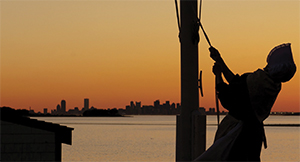The lighthouse stood tall atop the small rocky island in Boston’s outer harbor. Its profile against the horizon could be seen from a distance and grew larger during the approach. The keeper’s house, walkways and manicured lawns all came into focus, and then blurred as the eye was drawn to a white handkerchief waving against the blue sky.
Sally Snowman, keeper of Boston Light, welcomed the tour group the same way she always does. She waved her handkerchief — a gesture that has greeted generations of mariners returning from sea.
Light keepers have kept Boston Light illuminated for 300 years.
The tasks required to keep the light ablaze have evolved over time. Although technology has made Boston Light burn brighter and reach farther, the unchanged component has been the individual who oversees the beacon.
The constant has been the keeper — whose hand is responsible for the light that guides seafarers to safe harbor.
Today, that keeper is Sally Snowman.
“I think of keeper Snowman as a one-woman station,” said Capt. Claudia Gelzer, commander of Coast Guard Sector Boston.
“She truly embraces her job,” Gelzer said. “She grew up on Hull [Massachusetts], she looked out across the water as a little girl. It’s an incredible story that she ultimately became the light keeper.”
Being a 21st-century lighthouse keeper requires a unique set of skills. Snowman, who holds a Ph.D. and previously worked as a learning disabilities specialist, not only maintains the light but also oversees all of the tours.
From the moment she greets her visitors, wearing period-accurate dress, they are immersed in a full Boston Light experience. Her passion for the rich history of the lighthouse is evident to all who meet her.
During tours, visitors have the chance to see the inner workings of the light and climb the spiral staircase to view the 1859 Fresnel lens up close.
 |
The lens, which produces 12 beams of light that stretch for up to 27 miles, hasn’t always been a part of the lighthouse.
“Boston Light’s first light was a two-tiered chandelier with seven candles on each one,” Snowman said. Today you wouldn’t be able to see that against the backdrop of the bright city lights, she added.
People visit the island for various reasons, said Snowman. Some are interested in the maritime history aspect and others are simply drawn to it.
“A very unique thing occurs every night when the sun goes down,” said Snowman. “There are 12 separate rays that go out, and when there is any moisture in the air it really magnifies those beams, and they appear to drop down onto the horizon. It’s just an optical illusion. It feels so safe. Nothing is going to harm me. Those are the guardian lights.”
For Snowman, seafarers and scores of visitors, the light is a transcendent symbol.
“Think of everything that you’ve ever seen with a lighthouse,” said Snowman. “So many use that symbol for their business. And why? Because people trust it, it’s the hope, it’s the light.”
The light keeper is as much a part of the symbolism of hope as the light itself. For early mariners, the light was the first glimmer of civilization and the keeper the first person seen after perilous journeys.
Snowman embodies that legacy.
The importance of the light keeper was officially recognized in 1989 when congress passed a law stating Boston Light would always be manned.
“[Boston Light] will always have someone there to make sure she will burn bright and to maintain the island on which she sits,” said Gelzer.
Snowman, like her predecessors, keeps those beams burning — lighting the way for the next generation.

